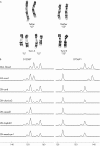Androgenetic/biparental mosaicism causes placental mesenchymal dysplasia
- PMID: 15908568
- PMCID: PMC2564642
- DOI: 10.1136/jmg.2005.033571
Androgenetic/biparental mosaicism causes placental mesenchymal dysplasia
Abstract
Background: Placental mesenchymal dysplasia (PMD) is a distinct syndrome of unknown aetiology that is associated with significant fetal morbidity and mortality. Intrauterine growth restriction is common, yet, paradoxically, many of the associated fetuses/newborns have been diagnosed with Beckwith-Wiedemann syndrome (BWS).
Methods: We report two cases of PMD with high levels of androgenetic (complete paternal uniparental isodisomy) cells in the placenta and document, in one case, a likely androgenetic contribution to the fetus as well.
Results: The same haploid paternal complement found in the androgenetic cells was present in coexisting biparental cells, suggesting origin from a single fertilisation event.
Conclusions: Preferential allocation of the normal cells into the trophoblast explains the absence of trophoblast overgrowth, a key feature of this syndrome. Interestingly, the distribution of androgenetic cells appears to differ from that reported for artificially created androgenetic mouse chimeras. Androgenetic mosaicism for the first time provides an aetiology for PMD, and may be a novel mechanism for BWS and unexplained intrauterine growth restriction.
Conflict of interest statement
Competing interests: none declared
References
-
- Fisher R A, Hodges M D. Genomic imprinting in gestational trophoblastic disease‐‐a review. Placenta 200324(Suppl A)S111–S118. - PubMed
-
- Barton S C, Surani M A, Norris M L. Role of paternal and maternal genomes in mouse development. Nature 1984311(5984)374–376. - PubMed
-
- Surani M A, Barton S C, Norris M L. Development of reconstituted mouse eggs suggests imprinting of the genome during gametogenesis. Nature 1984308(5959)548–550. - PubMed
-
- McFadden D E, Pantzar J T. Placental pathology of triploidy. Hum Pathol 1996271018–1020. - PubMed
-
- Gibson B R, Muir‐Padilla J, Champeaux A, Suarez E S. Mesenchymal dysplasia of the placenta. Placenta 200425(7)671–672. - PubMed
Publication types
MeSH terms
Substances
LinkOut - more resources
Full Text Sources



